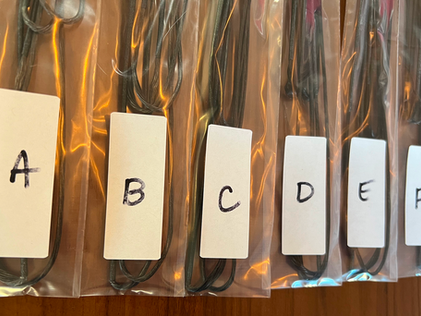top of page
Blog articles


The Data Behind How String Color Can Impact Performance and Precision
After building thousands of strings I know there is variation in the material. But how much and what do archers need to know?
Julie Bergen
Apr 186 min read


The Great American Shoot-off: String Material Week
Can archers really tell the difference between string materials? That's what Diane Cochran set out to determine when she contacted me proposing this testing late in 2024.
Julie Bergen
Apr 105 min read


Untangling String Twist Terminology
Your string should have twists in it. But when adding or removing twists, there is a lot of confusion about twist direction terminology.
Julie Bergen
Apr 22 min read


Featured on The Archery Parent Podcast
OCD Strings was honored to be featured on the Archery Parent Podcast , released on February 24, 2025! A huge thank you to Manisha for the...
Julie Bergen
Feb 2734 min read


2024 Nock Popularity Report
What were the most popular nocks used in 2024? Based on our customer orders, here are the findings.
Julie Bergen
Dec 31, 20241 min read


Customize your next center serving: How to measure
No matter the reason, here's how you can customize the measurement of your center serving for your next string.
Julie Bergen
Aug 27, 20242 min read


A word on archery safety from AI
We all know how important safety is in archery. Here's a brief review with humorous images from AI.
Julie Bergen
Apr 14, 20241 min read


How to order a custom string
It can be intimidating ordering your first custom bow string. There are a lot of details you may be asked about that you had never considered. When ordering a custom string it's essential that you provide accurate information about your bow and how you shoot. Hopefully this can help you order with confidence. | OCD Strings
Julie Bergen
Nov 26, 20234 min read


String materials :: New for 2023!
An updated look at how these materials stack up against each other based on what is available to archers today. | OCD Strings
Julie Bergen
Sep 30, 20233 min read


What string length do I need?
How can you overcome all the confusion and know what length string your bow actually needs?
Julie Bergen
Jul 23, 20232 min read


Which nocks am I shooting?
It's sometimes hard to tell which nocks you are using if you are not familiar with the vast variety out there! And when a manufacturer says they make a "small groove" nock, it is not necessarily the same as another manufacturer's "small groove" nock. Learn which nocks you are shooting with this guide.
Julie Bergen
May 14, 20232 min read


Barebow strings
The best way to determine where yours should be is by taking a photo of yourself at anchor at both your highest and lowest crawl positions. Let's keep it legal!
Julie Bergen
Apr 11, 20232 min read


Does string color matter?
Most archers select their string colors based on the color of their bow. And there's nothing wrong with that. But there are a few things to consider when choosing your next string color.
Julie Bergen
Apr 2, 20231 min read


Bow string autopsy
I've gotten a few requests to make strings to a particular weight. I'd love to accommodate such a request, but that's easier said than done.
Julie Bergen
Jul 3, 20222 min read


In the news again!
We are happy to announce that OCD Strings was featured in this publication for a second time in issue 157 of Bow International!
Julie Bergen
Jun 25, 20221 min read


Be prepared for competitions
It can be daunting to venture out to your first target archery competition. Everyone else seems to already know what to do and without a coach or team to guide you, you may feel a bit lost. Where do you get this information? Look no further. Here is everything you need to know!
Julie Bergen
Jun 25, 20227 min read


How do I measure my string length?
If you have been able to really get to know how your bow performs best and fine tune your brace height, you might want to get more specific about the length of your string. Also if you prefer a certain number of twists in your string, it may also be necessary to customize your string length beyond the manufacturer recommendation.
Julie Bergen
Dec 13, 20211 min read


On the web!
The Kifarucast Podcast, hosted by Aron Snyder and produced by Kifaru International, explores topics related to hunting, archery, and the outdoors. It is a go-to resource for gear enthusiasts, with episodes that dive deep into the latest outdoor and hunting equipment. OCD Strings was featured in their latest podcast episode.
Julie Bergen
Sep 2, 20211 min read


What is the difference between string materials?
8125, 652, 97, 99, 450, 8190, 777 ... bingo??? It sounds like the number edition of alphabet soup. What does all this mean and how do I choose the best string material for my needs?
Julie Bergen
Aug 18, 20213 min read


How should I care for my string?
Taking care of your string will extend its life and provide endless hours of happy shooting. Here's are a few things to keep in mind.
Julie Bergen
Jul 18, 20212 min read
bottom of page